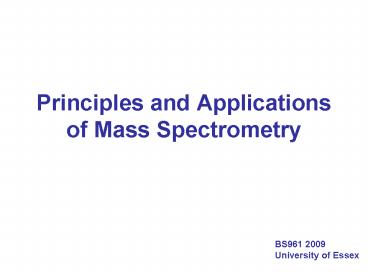Principles and Applications of Mass Spectrometry - PowerPoint PPT Presentation
1 / 23
Title:
Principles and Applications of Mass Spectrometry
Description:
... by their m/z ... rods using specifically tailored electromagnetic fields ... Several peaks with the same m/z which one is the real compounds. MS ... – PowerPoint PPT presentation
Number of Views:6125
Avg rating:3.0/5.0
Title: Principles and Applications of Mass Spectrometry
1
Principles and Applications of Mass Spectrometry
BS961 2009 University of Essex
2
- Introduction to mass spectrometry
- Basics concepts and terminology
- Instrumentation, ionization modes and types of
mass analyzers - Applications of mass spectrometry to the study
of biological molecules
.
3
- Mass spectrometry studies ions
- Mass spectrometers determine mass-to-charge
ratio of ions - The analysis is performed in the gas phase not
in solution - Structure can be elucidated by determining the
mass of fragments
4
- Mass spectrometry generates mass spectra
- A mass spectrum is a set of peaks one for each
ion that has been detected - Peaks are characterized by their m/z
- The height of the peak depends on the number of
ions of that particular m/z that has hit the
detector. This number is referred to as intensity
5
Monoisotopic and average mass
Because of the presence of natural isotopes in
the biological molecules we distinguish two types
of mass measurements monoisotopic and average
6
Resolution and accuracy
Resolution is defined as the ratio of the peak
mass divided by its width at half maximum. It can
also be expressed in FWHM units. FWHM Full
Width at Half Maximum. Mass accuracy is the
measure of the error relative to the theoretical
value
7
General design of a mass spectrometer
and MALDI
Ion Source Mass Analyzer
Detector Data Station
8
Types of ionization
Electron Impact - sample is heated and energized
by a beam of electrons, usually gives a molecular
ion (M) and a lot of fragments Chemical
Ionization sample is heated and ionized in the
presence of Cl and proton donors. Gives (MH)
ions and less fragments compared to EI Fast Atom
Bombardment softer than EI and CI. Ions are
produced by bombardment with heavy atoms. Gives
(MH) ions and litle fragmentation. Good for
more polar compounds.
9
Types of ionization
Matrix Assisted Laser Desorption Ionization
(MALDI) sample is co-crystallized with a matrix
and then irradiated with laser. Singly charged
(MH) and (M-H)- ions are produced. Good for
intact proteins.
10
Types of ionization
ElectroSpray Ionization sample is sprayed out
of a narrow nozzle in a high potential field.
Generates positive (MnH)n and negative (M -
nH)n- ions and almost no fragmentation. Generates
multiple charged ions.
11
(No Transcript)
12
Types of mass analyzers
Magnetic sector analyzer Uses electric and/or
magnetic fields to separate ions Time of Flight
analyzer (TOF) ions are accelerated through a
flight tube and the time of light to the detector
is measured Quadrupole analyzers ions are
filtered or trapped in a device consisting of
several metal rods using specifically tailored
electromagnetic fields Fourier Transform Ion
Cyclotron Resonance (FT ICR) analyzers very
expensive. Use a very high strength magnet to
trap ions in a circular orbits and measure their
resonance energies. Provide the highest
resolution and sensitivity
13
Magnetic sector instruments
Ions are deflected and accelerated down a curved
path to the detector.
14
Time of flight instruments
E (mv2)/2 (1)
v (2E/m)1/2 (2)
Ions are accelerated and their time of flight to
the detector is measured
15
Quadrupole analyzers
Ions are filtered by application of RF fields on
the quadrupole. The analyzer scans sequentionally
through the mass range by varying the RF
potential
16
Quadrupole ion trap analyzers
Ions are trapped by an oscillating RF voltage and
scanned out sequentially by changing the RF
voltage. Collision with He helps to cool the ions
and focus them in the centre of the trap. Ion
traps are cappable of MSn operation.
17
More about Ion Traps
18
More about Ion Traps
Ion trap geometry
Mathieu stability diagram
19
Tandem and Hybrid analyzers
TOF-TOF Q-TOF Triple Quad
Two consecutive tof analyzers with a collision
cell in between
A quadrupole mass filter followed by a collision
cell and a tof analyzer
Two consecutive quadrupole analyzers with a
collision cell in between
20
MS/MS and MSn
Full scan Precursor isolation
Fragmentation Detection
21
Auto MS/MS
The instrument alternates between MS and MS/MS
mode selecting precursors according preset
criteria
Selected precursors are added to the include
list to force their isolation and analysis
22
SIM and SRM
The instrument isolates just one predetermined
ion, fragments the isolated precursor (in SRM)
and then measures the intensity of a selected
fragment ion. This is very powerful
quantification method. It is extremely specific
and sensitive
Several peaks with the same m/z which one is
the real compounds
Both usually require separation by HPLC prior to
MS. SRM has much higher specificity MRM
simultaneous SRM of several precursors
23
MS analysis of biomolecules
Small molecules drugs, drug breakdown products,
sugars, lipids, amino acids, fatty acids and
their esters EI and CI (chemical ionization),
ESI, are used predominantly in combination with
sector, quadrupole and time-of-flight mass
analyzer
Biopolymers proteins, peptides,
oligonucleotides, carbohydrates ESI and MALDI
ionization mostly. All mass analyzers































